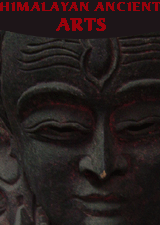Shop
By Type |
 |
|
|
|
|
|
|
|
|
|
|
|
|
|
|
|
|
|
|
|
|
|
|
|
|
|
|
|
|
|
|
|
|
|
|
|
|
|
|
|
|
|
|
|
|
|
|
|
|
|
|
|
|
|
|
|
|
|
|
|
|
 |
 |
Travel Packages  |
 |
 |
Newsletter |
 |
|
|
 |
|
 |
|
 |
|
 |
|
 |
|
 |
|
 |
|
 |
|
|
|
|
Tibetan Art and sculpture, paintings, folk music, folk dance, fresco, poetry and prose, clay molding, butter sculpture and mask was produced for religious purposes or was infused with Buddhist themes. Tibetan art, historically, has been entirely and exclusively religious, to that extent it is something of a philosophic art as well. Although much Tibetan art uses figuration, depicting person-like beings and creatures that, however mythological, supramundane, or surreal, are pseudo-realistic and thus recognizable, it differs fundamentally from Western art, specifically from religous art. Tibetan art depicts various classes and types of Buddhas, portrays human beings, including the historic Buddha Shakyamuni, as well as arhats, spiritual masters, great lamas, and founders of different religious lineages, the preponderance of its images depict supramundane beings. Tibetan art is an integral part of a spiritual practice and process. Tibetan art, uniquely, is an art that uses figuration and representational images to express abstraction.
Tibetan art is dominated by its greatest deities, the Bodhisattvas. Tibetan art uses a sort of visual alphabet or code, whose features help to identify various deities. These features include color, gesture, pose, dress, and the holding of symbolic objects.
|
| ............................................................................................................................................................................................................................ |
MORE ABOUT TIBETAN ART OF TIBET
|
|
| Flat Paintings of Tibetan Art |
| Solid Objects of Tibetan Art |
| Folk Music and Dance of Tibet |
| |
| FLAT PAINTINGS OF TIBETAN ART |
| Flat (2-dimensional) Paintings of Tibetan Art include `Thangka', Fresco, Wooden Tablet and Sand Painting. |
| |
| Thangka Paintings:
One of the best example of tibetan art is traditional Tibetan painting of a Buddha, Buddhist deity, or a mandala. Thangkas are framed in rich, colorful, silk brocades, but they are religious objects, not simply decorations. Such religious works of art function as models on which meditators can reflect, identifying and developing within themselves the qualities such as wisdom and compassion that are embodied in the painting. Thangka painting is strictly governed by iconographic rules. |
| |
Fresco :
Tibetan fresco painting is an important part of Tibetan art. The painting of Buddha image must follow the rigid principles and the proportion diagrams set out in the `Pratibimbalaksana-sutra' (`The Textbook on Measurements for Image-Making') and the `Pratibimbamana-laksana (`Measurements for Painting') in the Silpakarmasthana-vidya. The finished product is well-proportioned, stately and serene-looking deity.
The pigments used are similar to the one used for thangka painting. Frescoes covers wider range of subjects than thangkas do. They include the images of Buddha in his many manifestations, portraits of saints, great masters, founders of various Buddhist sects and the stories of their lives, wars, scenes of manual labour, construction of monastories and everyday life of the people. They are especially effective in creating a mystic atmosphere in the monasteries which will lead the viewers to believe that `this is where the Buddha resides'. |
|
Wooden Tablet Painting:
Wooden Tablet Painting represents yet another branch of Tibetan art. Its subjects and pictorial composition are similar to those of thangka and the difference is that the pictures are drawn on wooden tablets of various shapes. Some of them have handles attached to them for holding and hanging. |
| |
| SOLID OBJECTS FO TIBETAN ART |
Solid objects of tibetan art includes:
Bronze:
As Buddhism believes in the worship of idols (as against a teaching of Buddha), the production of the images of Buddhas and other deities must follow the strict rules prescribed in the cannon for their faces, gestures, the ornaments they wear and the objects they hold. The Tibetan artists absorbed the influences of the art of Han, Nepalese and Indian sculpture and developed a style and craft of their own which was distinctively Tibetan. The shapping of a bronze is a complicated process. It is so difficult and time-consuming that sometimes many artists spent all their lives making them but did not live to see them completed. |
| |
Clay Sculpture:
There are numerious Clay sculptures preserved to the present day. Most of them are sculptures of Buddhas, saints and great figures. Some of them are with treasures presereved inside. |
| |
Clay Molding:
Clay modeling of miniature Buddhist image, called `phyag-tsha' or `tsha-tsha' in Tibetan, represents a form of artistic expression in Tibetan Buddhism. As the modelings are not difficult to make and the material is easily obtainable, such objects of art are turned out in large quantities by Tibetan. They can be found almost everywhere. |
| |
Wooden and Stone Carving:
These beautiful engravings lavishly decorate the columns, beams, door, windows and cross-beam supports in Tibetan monasteries and temples. Shrines, platforms seating deities, altars, stupas and some ritual objects are often adorned with wood carving or stone carving. |
| |
Ritual object:
The numerous ritual objects of Tibetan Buddhism may be divided into six groups symbolizing respect, praise, attendance, devotion, protection and guidance. Kasayas, necklaces and hadas (ceremonious scarves) are symbols of respect. Bells, drums, bone flutes, and six-string lutes symbolize praise. The Buddhas' throne, water vessels, flower baskets, and canopies belong to the attendance group. Rosary beads, the fish-shaped wooden percussion instrument, scepters, bells, and initiation vessels are used to show devotion. Images of protecting deities, and written secret messages signify protection. Wheels, cylinders, tablets, banners and stones with the `Six-Syllable True Teaching' on them symbolize guidance. |
| |
Butter Sculpture:
Most Butter Sculptures produced in Lhasa and elsewhere are made for the Lamp Festival on the fifteenth day of the first month of the Tibetan year. The butter is first mixed with ice water, then mineral dyes mixed in. Working on a wooden support, a world of flowers and grass and towers and buildings, populated with men and animals and deities, is then created.
|
| |
Mask:
Masks depict the range of beings from deities to men and animals, qiangmu religious dances and folk tales. Those depicting humans are carved to display a certain characteristic such as honesty, harshness, greed or humor. Animals depicted are mainly deer, yaks, sheep and birds. |
| |
The Thousand-Buddha Wall:
"Cazha" is an ancient traditional form of sculpture creating mainly the statues of Buddhas and Bodhisattvas. Engraved on the back of the wall are scriptures of prayers for good luck and prosperity. The wall is an object of various size, the wall, therefore, is called "Thousand-Buddha wall". |
| |
| FOLK MUSIC AND DANCE OF TIBETAN ART |
Tibetan folk music and dance have been kept alive in the homes of Tibetans living in Tibet, India, and the West. At parties individuals are often asked to sing, and groups may dance. The songs offer greetings and good wishes or tell stories of drinking chang (Tibetan beer) or of lost love. Themes and styles vary greatly depending on the region in Tibet the songs are from. Folk songs are usually sung a capella or to the accompaniment of the pi wang (fiddle) or the dran yen (long-necked lute). Most folk dances are performed in a circle.
In India folk songs have been taught to new generations at the Tibetan Institute of Performing Arts (TIPA). The Dalai Lama established TIPA within six months of his escape from Tibet in 1959. TIPA continues to train hundreds of performers in folk dance and music as well as lhamo opera. In the United States, Chaksampa, a group of talented Tibetan musicians who are at this Festival, was organized to perform Tibetan music and dance throughout North America. Some Tibetan artists in Europe, Australia, and the United States, as well as in refugee communities, are recording folk music, adding new instruments, and introducing contemporary themes to their repertoire. |
| |
|
 |
|
 |
| |
|
|
| |
| |
|
|
 My
Shopping Basket My
Shopping Basket |
 |
| |
 Best
Seller Best
Seller |
 |
 |
 |
|
Grape Pashmina Shawl |
| Price: US$
71.43 |
|
|
|
| |
 Start
with your budget Start
with your budget |
 |
|
|
| |
 Tell
a friend Tell
a friend |
 |
Tell a friend and win exciting gifts...
Click here
to learn more. |
 |
 |
 |
 |
 |
 |
 |
| |
 |
|